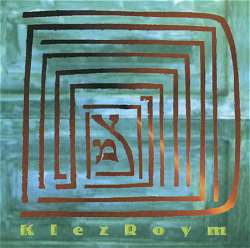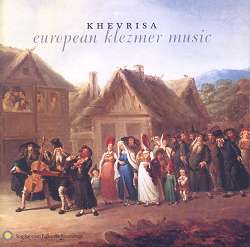 the swath of land from Poland to the Black Sea in which Eastern European Jews used to live, where it developed.
the swath of land from Poland to the Black Sea in which Eastern European Jews used to live, where it developed.
KlezRoym
Anagrumba GDL 1093
European klezmer music
Smithsonian Folkways SFW CD 40486
It caught on, and klezmer has been tremendously popular ever since, branching out into various directions. There are those who remain close to the example set by the first revival bands. There are those who want to inject the bubbling mixture with new ingredients. Others want to follow the path back to Europe, to envisage what klezmer may have sounded like in the Pale,  the swath of land from Poland to the Black Sea in which Eastern European Jews used to live, where it developed.
the swath of land from Poland to the Black Sea in which Eastern European Jews used to live, where it developed.
The Italian band KlezRoym belongs to the category of fusionists, adding pop and easy-jazz to the stew, smoothing the tunes with a particularly rich production. This is clear right from the start. The CD begins with slow melodies carefully played on clarinet and sax, underpinned by chords and runs on guitar and plucked notes on the violin. The playing is excellent. The sparsity of the instrumentation and arrangement creates a sensation of depth. ![]() But it is only a physical depth that is evoked. Somehow the technical quality stands in the way of an appeal to emotion (sound clip - New York).
But it is only a physical depth that is evoked. Somehow the technical quality stands in the way of an appeal to emotion (sound clip - New York).
By way of contradiction in musical terms this is klezmer in ready-made designer clothes. They have cast the sprightly bounce and the tragicomedy into an elegant pose, have withdrawn tongue from cheek.  KlezRoym seems to act klezmer, rather than play it.
KlezRoym seems to act klezmer, rather than play it. ![]() Their emphasis on well-crafted and well-groomed interpretations has boiled off the zaniness and the spontaneity from the music. This is candlelight klezmer (sound clip - Fel Shara). Until the very last cut, that is. After the twelfth track the counter keeps on running to 36. All tracks in between are silent and last no more than four seconds. What follows is a techno remix of one of the pieces on the album, Fel Shara. I can't make out whether this was meant to be cool or hilarious. It does strike me as utterly pointless.
Their emphasis on well-crafted and well-groomed interpretations has boiled off the zaniness and the spontaneity from the music. This is candlelight klezmer (sound clip - Fel Shara). Until the very last cut, that is. After the twelfth track the counter keeps on running to 36. All tracks in between are silent and last no more than four seconds. What follows is a techno remix of one of the pieces on the album, Fel Shara. I can't make out whether this was meant to be cool or hilarious. It does strike me as utterly pointless.
While KlezRoym are devising new trajectories for the style, the musicians of Khevrisa are heading in the opposite direction, retracing it to its Eastern European origins. Initiated by cimbalist Walter Zev Feldman and violinist Steven Greenman, two pioneers from the 1970s klezmer revival, Khevrisa is as much a musical as a scholarly project. Backed by eminent players in the scene (Alicia Svigals and Michael Alpert on violin, and bassist Stuart Brotman), their performance is built both on research and on years of experience as musicians in this field.
They have done away with brass, woodwinds and percussion, the instruments that gave klezmer its typically American jazzy flavour![]() .
.  Khevrisa is all string, making the character of the music less frenzied and cheeky, more intimate (sound clip - Sher). Having shed the cloak of novelty music, this approach to klezmer gives it a light touch, touching the heart with confident immediacy. The soft tone of the violin is wonderfully effective in this respect.
Khevrisa is all string, making the character of the music less frenzied and cheeky, more intimate (sound clip - Sher). Having shed the cloak of novelty music, this approach to klezmer gives it a light touch, touching the heart with confident immediacy. The soft tone of the violin is wonderfully effective in this respect. ![]() Its warmth is matched by the buzzy tinkle of the cimbal. Both instruments are captured in all their richness of timbre. Especially the resonance of the cimbal is a treat (sound clip - Steiner's Khosidl).
Its warmth is matched by the buzzy tinkle of the cimbal. Both instruments are captured in all their richness of timbre. Especially the resonance of the cimbal is a treat (sound clip - Steiner's Khosidl).
It almost goes without saying that this CD comes with extensive notes, giving more insight in the development of klezmer music in 19th century Eastern Europe.  Given the fact that much documentation must have disappeared in the brutally destructive history of the Pale since the first pogroms in the Ukraine (which forced Jews into emigration - taking with them, as part of their rich heritage, their music), Greenman's and Feldman's achievement in revitalizing this specific music is astonishing.
Given the fact that much documentation must have disappeared in the brutally destructive history of the Pale since the first pogroms in the Ukraine (which forced Jews into emigration - taking with them, as part of their rich heritage, their music), Greenman's and Feldman's achievement in revitalizing this specific music is astonishing.
Perhaps it is a bit unfair to treat KlezRoym together with Khevrisa - there must needs be a wide gap between newcomers and veterans. On the other hand, both seem to work from an awareness that in order to stay alive a musical style has to undergo change. What is interesting, is that (from very different motivations, certainly) they have come up with answers that stand in diametrical opposition to each other. Where the Italians are centripetal, the Americans are centrifugal. Whereas the former drag it across the borders into pop territory, the latter feed knowledge of the roots back into the experience of the stem. One makes klezmer vague and hazy, the other substantiates it.
René van Peer - 1.6.00
| Top of page | Home Page | Articles | Reviews | News | Editorial | Map |